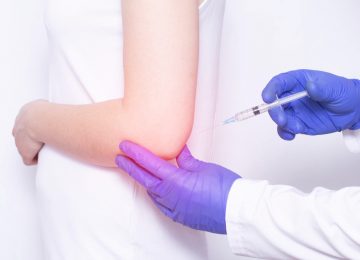What is golfer’s elbow?
Golfer’s elbow is otherwise known as medial epicondylitis. It is a condition affecting the bony lump on the inner or medial aspect of the elbow joint. This bony lump acts as the attachment site for a group of forearm muscles, responsible for flexing the wrist and fingers. These muscles converge to form a common flexor tendon, which attaches to the medial epicondyle of the bone, causing pain when injured.
Why does golfer’s elbow occur?
This condition is often associated with overuse of the tendons, causing trauma within the tissue where it attaches to the elbow. The normal healing process is interrupted, and fibrous (scar) tissue begins to form. The altered tissue within the tendon makes repeated attempts to heal, leaving further painful scar tissue.
Golfer’s elbow symptoms
Irritation of the tendon can cause pain or tenderness around the inner surface of the elbow, or more commonly at the bony attachment site. This is aggravated during certain movements, such as flexing the forearm or wrist; or repetitive movements involving the tendons, such as using a screwdriver.
How is golfer’s elbow diagnosed?
A diagnosis of golfer’s elbow is often confirmed following a thorough medical history and physical examination. Further imaging including x-rays or MRI scans may be used to rule out alternative diagnoses.
How is golfer’s elbow treated?
Non-surgical
Initial treatment includes rest, ice and anti-inflammatory medications. Arm braces or wrist splints can also be effective, particularly alongside physiotherapy. Specific exercises are used to stretch out the tendons and reduce the pull where the tendon attaches to the medial epicondyle of the bone.
If the pain continues, steroid injections are successful in relieving symptoms by reducing inflammation. They would normally be followed with a course of physiotherapy to reduce the chance of recurrence.
Platelet-rich plasma (PRP) injections are being used more and more where conservative treatment is not effective. A solution is extracted from the patient’s own blood, rich in growth factors which aid tendon healing.
Surgical
Surgical intervention for golfer’s elbow is rare. If other treatments are ineffective and other causes of pain have been ruled out after six months, surgery may then be considered. Further imaging including x-rays and scans may be required, as well as diagnostic arthroscopy or keyhole surgery, to obtain a definitive diagnosis.
The One Orthopaedics team specialists

Anthony Hearnden
Consultant Orthopaedic Surgeon FRCS (Tr&Orth), Shoulder, Elbow, Hand and Wrist








